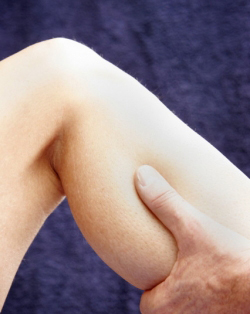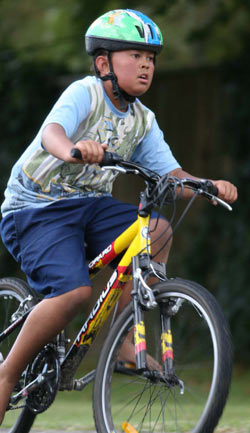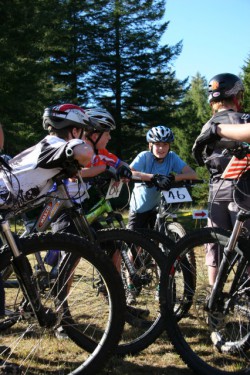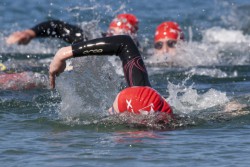Fitness Blog Covering Topics Of Interest
Monday, October 05 2015
The next time you have a check-up, don’t be surprised if your doctor hands you a prescription to walk. Yes, this simple activity that you’ve been doing since you were about a year old is now being touted as “the closest thing we have to a wonder drug,” in the words of Dr. Thomas Frieden, director of the Centers for Disease Control and Prevention.
Of course, you probably know that any physical activity, including walking, is a boon to your overall health. But walking in particular comes with a host of benefits. Here’s a list of five that may surprise you.
1. It counteracts the effects of weight-promoting genes. Harvard researchers looked at 32 obesity-promoting genes in over 12,000 people to determine how much these genes actually contribute to body weight. They then discovered that, among the study participants who walked briskly for about an hour a day, the effects of those genes were cut in half.
2. It helps tame a sweet tooth. A pair of studies from the University of Exeter found that a 15-minute walk can curb cravings for chocolate and even reduce the amount of chocolate you eat in stressful situations. And the latest research confirms that walking can reduce cravings and intake of a variety of sugary snacks.
3. It reduces the risk of developing breast cancer. Researchers already know that any kind of physical activity blunts the risk of breast cancer. But an American Cancer Society study that zeroed in on walking found that women who walked seven or more hours a week had a 14% lower risk of breast cancer than those who walked three hours or fewer per week. And walking provided this protection even for the women with breast cancer risk factors, such as being overweight or using supplemental hormones.
4. It eases joint pain. Several studies have found that walking reduces arthritis-related pain, and that walking five to six miles a week can even prevent arthritis from forming in the first place. Walking protects the joints — especially the knees and hips, which are most susceptible to osteoarthritis — by lubricating them and strengthening the muscles that support them.
5. It boosts immune function. Walking can help protect you during cold and flu season. A study of over 1,000 men and women found that those who walked at least 20 minutes a day, at least 5 days a week, had 43% fewer sick days than those who exercised once a week or less. And if they did get sick, it was for a shorter duration, and their symptoms were milder.
Thursday, July 16 2015
Mobility — the ability to move purposefully around your environment — is vitally important to health and well-being.
Nearly one-third to one-half of adults ages 65 and older experience impaired mobility. At first, it may not seem like a big deal — many people with impaired mobility learn to just move a little more slowly and a little more deliberately. Some people work around the problem by relying on a cane or walker.
That’s why it’s important to intervene to either prevent future mobility impairments or reduce existing ones.But taking impaired mobility “lying down” can cause your health to spiral downward. As you move less, pounds may start to creep on. You might withdraw from social relationships and activities that challenge you mentally. Exercise may become difficult, and lack of activity can worsen many health problems. This cycle of physical, emotional, and mental decline further restricts mobility.
For most people, the ability to rely on their own bodies, skills, and mental agility is a crucial part of living a satisfying life. Having full mobility helps you fully engage with the world and fosters a sense of self-sufficiency that can help you live independently well into your later years.
Friday, September 05 2014
Fruits and vegetables contain vitamins, minerals, and other nutrients that are essential for good health. That’s one reason why a plant-based diet that includes lots of fruits and vegetables can lower your risk of developing life-threatening diseases such as heart disease, diabetes, and some cancers. And when you pile on the produce, there’s less room for the unhealthy foods.
Dinner is typically the largest (and latest) meal of the day, and it’s a good opportunity to make sure that you meet your daily quota for fruits and vegetables. Here are five easy ways to work more produce into dinner.
- Roast vegetables. Roasting is a great way to let the deep, rich flavors of vegetables shine through. Bake cut vegetables at 375° F for 20 to 25 minutes or until they’re lightly browned. You can roast any vegetable — from mushrooms, onions, eggplant, and zucchini to tomatoes, broccoli, and carrots — so don’t limit yourself. Enjoy roasted veggies as a side dish or toss them into pasta dishes and other recipes.
- Poach veggies in low-sodium chicken broth and white wine. To poach, boil enough liquid to cover the vegetables. When it boils, add the vegetables. Turn down the heat to just below boiling and cook the vegetables for about five to seven minutes, until they’re brightly colored and tender-crisp. Add garlic, basil, or tarragon for a flavor bonus. To retain nutrients, keep a watchful eye on the pot, or set a timer so you don’t overcook.
- Smuggle fresh cut vegetables into main dishes. Try adding mushrooms, peppers, zucchini, onions, or carrots into pasta sauce, casseroles, soup, stews, scrambled eggs, and chili.
- Have a salad with dinner most days. Stock your salad with dark green leafy lettuce and toss in petite peas, tomatoes, onions, celery, carrots, and peppers. As an added benefit, starting meals with a salad can help you consume fewer calories at the meal, as long as the salad is no more than 100 calories. A healthful salad consists of about 3 cups of dark green lettuce, 1⁄2 cup carrots, a tomato, 1⁄4 cucumber, and 1 1⁄2 tablespoons of low-calorie dressing.
- Choose fruit — fresh or frozen, stewed or baked — for dessert. It all counts toward your daily produce quota. Dried fruits are healthy but high in calories, so eat them sparingly.
Thursday, May 15 2014
The prostate is can be a troublesome little gland. It is prone to painful infections and inflammation (prostatitis), enlargement that interferes with urination (benign prostatic hyperplasia, or BPH), and cancer. Prevention is the best medicine, something exercise can help with. Exercise has also been shown to help treat various prostate-related conditions.
Although relatively few studies have looked at the impact of exercise specifically on prostate health, the ones that have suggest that regular physical activity can be good for this walnut-sized gland.
BPH prevention. In the ongoing Harvard-based Health Professionals Follow-up Study, men who were more physically active were less likely to suffer from BPH. Even low- to moderate-intensity physical activity, such as walking regularly at a moderate pace, yielded benefits.
Prostatitis treatment. Italian researchers conducted a randomized controlled trial (considered the gold standard of medical research) in men with chronic prostatitis. Those in the aerobic exercise group walked briskly three times a week. A comparison group did non-aerobic exercise (leg lifts, sit ups, and stretching) three times a week. At the end of 18 weeks, men in both groups felt better, but those doing aerobic exercises reported less prostatitis pain, less anxiety and depression, and better quality of life.
Prostate cancer progression. In a study of more than 1,400 men diagnosed with early-stage prostate cancer, men who walked briskly (not leisurely) for at least three hours a week were 57% less likely to have their cancer progress than those who walked less often and less vigorously. In an analysis from the Health Professionals Follow-up Study, men diagnosed with localized prostate cancer who engaged in vigorous activity at least three hours each week had a 61% lower chance of dying from the illness, compared to men who engaged in vigorous activity less than one hour a week.
How to get started
A well-rounded exercise program that includes a half-hour of physical activity on all or most days of the week delivers solid health benefits. And you needn’t perform this activity all at once; you can break it up into three 10-minute segments.
As always, talk to your doctor before beginning an exercise program. He or she can help you develop a routine based on your health and fitness level.
Saturday, February 15 2014
If you have diabetes — or for that matter, nearly any other chronic illness — exercise is one of the most powerful tools that can help you control your weight and blood sugar. And it can help you feel great, too.
The list of exercise benefits is long. Exercise helps control weight, lowers blood pressure, reduces harmful LDL cholesterol and triglycerides, raises healthy HDL cholesterol, strengthens muscles and bones, and reduces anxiety. Exercise can help regulate blood sugar and increase the body’s sensitivity to insulin. Both are important for people with diabetes.
Many studies have documented that exercise is a strong ally in treating diabetes. Here are a few examples:
- All forms of exercise — aerobic, resistance, and a combination of both — have been shown to be equally good at lowering HbA1c values.
- Resistance training and aerobic exercise both helped to lower insulin resistance in previously sedentary older adults at risk for diabetes. Combining the two was better than either one alone.
- People with diabetes who walked at least two hours a week were less likely to die of heart disease than their sedentary counterparts, and those who exercised three to four hours a week cut their risk even more.
- Women with diabetes who spent at least four hours a week doing moderate or vigorous exercise had a 40% lower risk of developing heart disease than those who didn’t exercise.
If you have diabetes, generally it is best to exercise one to three hours after eating, when your blood sugar level is likely to be higher. If you use insulin, be sure to test your blood sugar before exercising. If it is below 100 mg/dL, eat a piece of fruit or have a small snack. This will bump your blood sugar up and help you avoid hypoglycemia. Test again 30 minutes after your snack to be sure your blood sugar level is stable. It’s also a good idea to check your blood sugar after any particularly grueling workout or activity. If you’re taking insulin, your risk of developing hypoglycemia may be highest six to 12 hours after exercising. Experts also caution against exercising if your blood sugar is too high (over 250).
A medical alert bracelet should be part of your workout wardrobe. It should indicate that you have diabetes and whether you take insulin. Also, keep hard candy or glucose tablets with you while exercising in case your blood sugar takes a nosedive.
To learn more about how to live a healthy life with diabetes and ways to keep your blood sugar in check and avoid complications, contact Ronald @gyminmotion 07929 256856.
Sunday, April 07 2013
Legumes play an important role in traditional diets in many parts of the world. They are low in fat, are good sources of protein and fiber, and contain a variety of micronutrients and phytoestrogens (plant estrogens). Phytoestrogens have received a lot of attention for their ability to fight not only cancer, but also heart disease and osteoporosis. They help balance hormones in the body and thus are thought to be particularly valuable for the hormone-dependent cancers: breast cancer and prostate cancer. It is well known that male hormones play a role in prostate cancer development.
Despite their advantages, legumes play a minor role in most Western diets. The typical Western based diet (lower in vegetables and legumes and higher in animal-based foods) can cause an increase in both male and female hormones (androgens and estrogens), while a plant-based diet tends to lower these hormones. This is the basis for the role of diet in the development of hormone-dependent cancers.
Soy foods, such as tofu, soy milk, soy beans, and vegetarian burgers, seem to be particularly rich in cancer-fighting properties. This is at least partially due to a form of phytoestrogen, called isoflavones, that is found primarily in soy. It appears to help prevent prostate cancer by binding to male hormone receptors in the prostate, thus reducing the stimulating effect of male hormones on prostate cell growth.
Epidemiological studies have shown that high levels of isoflavones are often associated with low rates of breast, colon, and prostate cancer. This has been used to explain why countries such as Japan and China that typically consume large amounts of soy have lower risks of these diseases.
The difficulty with consuming soy for reducing risk of prostate cancer is the lack of clinical trial evidence to support its use. As with any dietary component, it is difficult to isolate the effect of a particular food type to prove its effectiveness. One prospective study, including over 12,000 men, did evaluate consumption of soy milk. It found that those who drank soy milk regularly had a reduced risk of prostate cancer. The relationship held up after other factors were controlled for. Other studies need to be done to further establish the benefits of soy. In the meantime, getting more soy foods into your diet can be healthy for many reasons, and lowering your risk of prostate cancer may be one of these.
Wednesday, March 13 2013
The prostate gland depends on testosterone for growth and development. Prostate cells, both noncancer and cancer, do too. This is why prostate cancer is sometimes referred to as a hormone-dependent cancer. Higher levels of circulating testosterone lead to higher concentrations in the prostate, and this appears to increase the risk of clinically significant prostate cancer. However, higher testosterone levels are not consistently found in prostate cancer patients, so there is more to the relationship.
A possible protective role of exercise has been proposed based on its ability to lower testosterone levels and to boost the immune system. Exercise causes a temporary reduction in testosterone, so regular exercise can reduce long-term exposure to testosterone. And chronic exercise has been shown to increase the number and activity of natural killer cells, which are part of the immune system that attack cancer cells.
Based on these effects, it seems that exercise should be beneficial, but the evidence concerning the impact of exercise on prostate cancer risk is inconclusive. In a review of 17 epidemiological studies of varying quality, 9 showed a beneficial effect, 5 no effect, and the other 3 actually showed an increased risk related to exercise or physical activity. None of the studies, however, provided conclusive proof, but taken together, they seem to support a weak beneficial effect of regular exercise on prostate cancer risk.
The challenge is proving that men who exercise regularly develop less prostate cancer when all other factors are the same. This requires a prospective long-term randomized study, and this probably will never be done. The best long-term prospective studies that looked at habitual physical activity in adulthood are encouraging, however.
A study of nearly 18,000 alumni of Harvard University showed that those who maintained a high level of physical activity were about half as likely to develop prostate cancer after the age of 70 as those who were least active. Another prospective study evaluated the level of physical fitness, as well as physical activity, on the risk of prostate cancer. Higher fitness levels were associated with lower risk in men under 60, but not in older men. And men who expended more than 1,000 kcal per week in exercise had lower risk than those who did not get this much exercise. The best long-term study of men's health is the Health Professionals Follow-up Study. It began in 1986 and has followed over 47,000 men in various health occupations since then. Data was collected in the beginning, and periodically through the study, on many factors including physical activity. The only positive result through 1994 was that at least 3 hours per week of vigorous physical activity was associated with a reduced risk of metastatic prostate cancer. But no relationship was observed between physical activity and the incidence of total or advanced prostate cancer. The same study, however, found an inverse relation between physical activity and BPH, more activity meant a lower likelihood of urinary symptoms or surgery for BPH. Walking 2–3 hours per week was enough to lower the risk of BPH.
The bottom line is that questions remain about the relation between exercise and prostate cancer, but there is no question that regular exercise is good for general health. So, it is wise to get some moderate exercise on most days of the week, and you may be protecting yourself from prostate problems, too.
Tuesday, March 05 2013
Vitamin D Deficiency: A Global Concern
If you live north of the line connecting San Francisco to Philadelphia and Athens to Beijing, odds are that you don’t get enough vitamin D. The same holds true if you don’t get outside for at least a 15-minute daily walk in the sun. African-Americans and others with dark skin, as well as older individuals, tend to have much lower levels of vitamin D, as do people who are overweight or obese.
Worldwide, an estimated 1 billion people have inadequate levels of vitamin D in their blood, and deficiencies can be found in all ethnicities and age groups. (1-3) Indeed, in industrialized countries, doctors are even seeing the resurgence of rickets, the bone-weakening disease that had been largely eradicated through vitamin D fortification. (4-6)
Why are these widespread vitamin D deficiencies of such great concern? Because research conducted over the past decade suggests that vitamin D plays a much broader disease-fighting role than once thought.
Being “D-ficient” may increase the risk of a host of chronic diseases, such as osteoporosis, heart disease, some cancers, and multiple sclerosis, as well as infectious diseases, such as tuberculosis and even the seasonal flu.
Currently, there’s scientific debate about how much vitamin D people need each day. The Institute of Medicine, in a long-awaited report released on November 30, 2010 recommends tripling the daily vitamin D intake for children and adults in the U.S. and Canada, to 600 IU per day. (7) The report also recognized the safety of vitamin D by increasing the upper limit from 2,000 to 4,000 IU per day, and acknowledged that even at 4,000 IU per day, there was no good evidence of harm. The new guidelines, however, are overly conservative about the recommended intake, and they do not give enough weight to some of the latest science on vitamin D and health. For bone health and chronic disease prevention, many people are likely to need more vitamin D than even these new government guidelines recommend.
Vitamin D Sources and Function
Vitamin D is both a nutrient we eat and a hormone our bodies make. Few foods are naturally rich in vitamin D, so the biggest dietary sources of vitamin D are fortified foods and vitamin supplements. Good sources include dairy products and breakfast cereals (both of which are fortified with vitamin D), and fatty fish such as salmon and tuna.
For most people, the best way to get enough vitamin D is taking a supplement, but the level in most multivitamins (400 IU) is too low. Encouragingly, some manufacturers have begun adding 800 or 1,000 IU of vitamin D to their standard multivitamin preparations. If the multivitamin you take does not have 1,000 IU of vitamin D, you may want to consider adding a separate vitamin D supplement, especially if you don’t spend much time in the sun. Talk to your healthcare provider.
Two forms of vitamin D are used in supplements: vitamin D2 (“ergocalciferol,” or pre-vitamin D) and vitamin D3 (“cholecalciferol”). Vitamin D3 is chemically indistinguishable from the form of vitamin D produced in the body.
The body also manufactures vitamin D from cholesterol, through a process triggered by the action of sunlight on skin, hence its nickname, “the sunshine vitamin.” Yet some people do not make enough vitamin D from the sun, among them, people who have a darker skin tone, who are overweight, who are older, and who cover up when they are in the sun. (1)
Correctly applied sunscreen reduces our ability to absorb vitamin D by more than 90 percent. (8) And not all sunlight is created equal: The sun’s ultraviolet B (UVB) rays—the so-called “tanning” rays, and the rays that trigger the skin to produce vitamin D—are stronger near the equator and weaker at higher latitudes. So in the fall and winter, people who live at higher latitudes (in the northern U.S. and Europe, for example) can’t make much if any vitamin D from the sun. (8)
Vitamin D helps ensure that the body absorbs and retains calcium and phosphorus, both critical for building bone. Laboratory studies show that vitamin D can reduce cancer cell growth and plays a critical role in controlling infections. Many of the body’s organs and tissues have receptors for vitamin D, and scientists are still teasing out its other possible functions.
New Vitamin D Research: Beyond Building Bones
Several promising areas of vitamin D research look far beyond vitamin D’s role in building bones. And, as you might expect, the news media release a flurry of reports every time another study links vitamin D to some new ailment. These reports can be confusing, however, because some studies are stronger than others, and any report needs to be interpreted in the light of all other evidence. More answers may come from randomized trials, such as the VITamin D and OmegA-3 TriaL (VITAL), which will enroll 20,000 healthy men and women to see if taking 2,000 IU of vitamin D or 1,000 mg of fish oil daily lowers the risk of cancer, heart disease, and stroke.
Here, we provide an overview of some of the more promising areas of vitamin D research, highlighting the complex role of vitamin D in disease prevention—and the many unanswered questions that remain.
Vitamin D and Bone and Muscle Strength
Several studies link low vitamin D levels with an increased risk of fractures in older adults, and they suggest that vitamin D supplementation may prevent such fractures—as long as it is taken in a high enough dose. (9-13)
A summary of the evidence comes from a combined analysis of 12 fracture prevention trials that included more than 40,000 elderly people, most of them women. Researchers found that high intakes of vitamin D supplements—of about 800 IU per day—reduced hip and non-spine fractures by 20 percent, while lower intakes (400 IU or less) failed to offer any fracture prevention benefit. (13)
Vitamin D may also help increase muscle strength, which in turn helps to prevent falls, a common problem that leads to substantial disability and death in older people. (14-16) Once again, vitamin D dose matters: A combined analysis of multiple studies found that taking 700 to 1,000 IU of vitamin D per day lowered the risk of falls by 19 percent, but taking 200 to 600 IU per day did not offer any such protection. (17)
A recent vitamin D trial drew headlines for its unexpected finding that a very high dose of vitamin D increased fracture and fall risk in older women. (18) The trial’s vitamin D dose—500,000 IU taken in a once-a-year pill—was much higher than previously tested in an annual regimen. After up to 5 years of treatment, women in the vitamin D group had a 15 percent higher fall risk and a 26 percent higher fracture risk than women who received the placebo.
It’s possible that giving the vitamin D in one large dose, rather than in several doses spread throughout the year, led to the increased risk. (18) The study authors note that only one other study—also a high-dose, once-a-year regimen—found vitamin D to increase fracture risk; no other studies have found vitamin D to increase the risk of falls. Furthermore, there’s strong evidence that more moderate doses of vitamin D taken daily or weekly protect against fractures and falls—and are safe.
So what is the significance of this study for people who want to take vitamin D supplements? A reasonable conclusion would be to continue taking moderate doses of vitamin D regularly, since these have a strong safety record, but to avoid extremely high single doses. This recent finding does present a challenge to scientists who will work to understand why the extreme single dose appears to have adverse effects.
Vitamin D and Heart Disease
The heart is basically a large muscle, and like skeletal muscle, it has receptors for vitamin D. (19) So perhaps it’s no surprise that studies are finding vitamin D deficiency may be linked to heart disease. The Health Professional Follow-Up Study checked the vitamin D blood levels in nearly 50,000 men who were healthy, and then followed them for 10 years. (20) They found that men who were deficient in vitamin D were twice as likely to have a heart attack as men who had adequate levels of vitamin D. Other studies have found that low vitamin D levels were associated with higher risk of heart failure, sudden cardiac death, stroke, overall cardiovascular disease, and cardiovascular death. (21-24) How exactly might vitamin D help prevent heart disease? There’s evidence that vitamin D plays a role in controlling blood pressure and preventing artery damage, and this may explain these findings. (25) Still, more research is needed before we can be confident of these benefits.
Vitamin D and Cancer
Nearly 30 years ago, researchers noticed an intriguing relationship between colon cancer deaths and geographic location: People who lived at higher latitudes, such as in the northern U.S., had higher rates of death from colon cancer than people who live closer to the equator. (26) Many scientific hypotheses about vitamin D and disease stem from studies that have compared solar radiation and disease rates in different countries. These can be a good starting point for other research but don’t provide the most definitive information. The sun’s UVB rays are weaker at higher latitudes, and in turn, people’s vitamin D levels in these high latitude locales tend to be lower. This led to the hypothesis that low vitamin D levels might somehow increase colon cancer risk. (2)
Since then, dozens of studies suggest an association between low vitamin D levels and increased risks of colon and other cancers. (1,27) The evidence is strongest for colorectal cancer, with most (but not all) observational studies finding that the lower the vitamin D levels, the higher the risk of these diseases. (28-38) Vitamin D levels may also predict cancer survival, but evidence for this is still limited. (27) Yet finding such associations does not necessarily mean that taking vitamin D supplements will lower cancer risk.
The VITAL trial will look specifically at whether vitamin D supplements lower cancer risk. It will be years, though, before it releases any results. It could also fail to detect a real benefit of vitamin D, for several reasons: If people in the placebo group decide on their own to take vitamin D supplements, that could minimize any differences between the placebo group and the supplement group; the study may not follow participants for a long enough time to show a cancer prevention benefit; or study participants may be starting supplements too late in life to lower their cancer risk. In the meantime, based on the evidence to date, 16 scientists have circulated a “call for action” on vitamin D and cancer prevention: (27) Given the high rates of vitamin D deficiency in North America, the strong evidence for reduction of osteoporosis and fractures, the potential cancer-fighting benefits of vitamin D, and the low risk of vitamin D supplementation, they recommend widespread vitamin D supplementation of 2000 IU per day. (27)
Vitamin D and Immune Function
 Vitamin D’s role in regulating the immune system has led scientists to explore two parallel research paths: Does vitamin D deficiency contribute to the development of multiple sclerosis, type 1 diabetes, and other so-called “autoimmune” diseases, where the body’s immune system attacks its own organs and tissues? And could vitamin D supplements help boost our body’s defenses to fight infectious disease, such as tuberculosis and seasonal flu? This is a hot research area and more findings will be emerging. Vitamin D’s role in regulating the immune system has led scientists to explore two parallel research paths: Does vitamin D deficiency contribute to the development of multiple sclerosis, type 1 diabetes, and other so-called “autoimmune” diseases, where the body’s immune system attacks its own organs and tissues? And could vitamin D supplements help boost our body’s defenses to fight infectious disease, such as tuberculosis and seasonal flu? This is a hot research area and more findings will be emerging.
Vitamin D and Multiple Sclerosis: Multiple sclerosis (MS) rates are much higher far north (or far south) of the equator than in sunnier climes, and researchers suspect that chronic vitamin D deficiencies may be one reason why. One prospective study to look at this question found that among white men and women, those with the highest vitamin D blood levels had a 62 percent lower risk of developing MS than those with the lowest vitamin D levels. (39) The study didn’t find this effect among black men and women, most likely because there were fewer black study participants and most of them had low vitamin D levels, making it harder to find any link between vitamin D and MS if one exists.
Vitamin D and Type 1 Diabetes: Type 1 diabetes is another disease that varies with geography—a child in Finland is about 400 times more likely to develop it than a child in Venezuela. (40) Evidence that vitamin D may play a role in preventing type 1 diabetes comes from a 30-year study that followed more than 10,000 Finnish children from birth: Children who regularly received vitamin D supplements during infancy had a nearly 90 percent lower risk of developing type 1 diabetes than those who did not receive supplements. (41) Other European case-control studies, when analyzed together, also suggest that vitamin D may help protect against type 1 diabetes. (42) No randomized controlled trials have tested this notion, and it is not clear that they would be possible to conduct.
Vitamin D, the Flu, and the Common Cold: The flu virus wreaks the most havoc in the winter, abating in the summer months. This seasonality led a British doctor to hypothesize that a sunlight-related “seasonal stimulus” triggered influenza outbreaks. (43) More than 20 years after this initial hypothesis, several scientists published a paper suggesting that vitamin D may be the seasonal stimulus. (44) Among the evidence they cite:
- Vitamin D levels are lowest in the winter months. (44)
- The active form of vitamin D tempers the damaging inflammatory response of some white blood cells, while it also boosts immune cells’ production of microbe-fighting proteins. (44)
- Children who have vitamin D-deficiency rickets are more likely to get respiratory infections, while children exposed to sunlight seem to have fewer respiratory infections. (44)
- Adults who have low vitamin D levels are more likely to report having had a recent cough, cold, or upper respiratory tract infection. (45)
A recent randomized controlled trial in Japanese school children tested whether taking daily vitamin D supplements would prevent seasonal flu. (46) The trial followed nearly 340 children for four months during the height of the winter flu season. Half of the study participants received pills that contained 1,200 IU of vitamin D; the other half received placebo pills. Researchers found that type A influenza rates in the vitamin D group were about 40 percent lower than in the placebo group; there was no significant difference in type B influenza rates. This was a small but promising study, and more research is needed before we can definitively say that vitamin D protects against the flu. But don’t skip your flu shot, even if vitamin D has some benefit.
Vitamin D and Tuberculosis: Before the advent of antibiotics, sunlight and sun lamps were part of the standard treatment for tuberculosis (TB). (47) More recent research suggests that the “sunshine vitamin” may be linked to TB risk. Several case-control studies, when analyzed together, suggest that people diagnosed with tuberculosis have lower vitamin D levels than healthy people of similar age and other characteristics. (48) Such studies do not follow individuals over time, so they cannot tell us whether vitamin D deficiency led to the increased TB risk or whether taking vitamin D supplements would prevent TB. There are also genetic differences in the receptor that binds vitamin D, and these differences may influence TB risk. (49) Again, more research is needed. (49)
Vitamin D and Risk of Premature Death
A promising report in the Archives of Internal Medicine suggests that taking vitamin D supplements may even reduce overall mortality rates: A combined analysis of multiple studies found that taking modest levels of vitamin D supplements was associated with a statistically significant 7 percent reduction in mortality from any cause. (50) The analysis looked at the findings from 18 randomized controlled trials that enrolled a total of nearly 60,000 study participants; most of the study participants took between 400 and 800 IU of vitamin D per day for an average of five years. Keep in mind that this analysis has several limitations, chief among them the fact that the studies it included were not designed to explore mortality in general, or explore specific causes of death. More research is needed before any broad claims can be made about vitamin D and mortality. (51)
Monday, January 07 2013

Sports massage is a form of massage therapy that is tailored to treat the needs of athletes. The use and application of specific techniques is the foundation of sports massage, yet what distinguishes it from other modalities is the intention behind the therapy. Many of us might think of massage as relaxing and holistic. Sports massage, in contrast, is designed to achieve specific goals, such as increasing performance or treating or preventing injury. The purpose of a sports massage session can vary, depending upon numerous factors that are unique to each athlete. For instance, sports massage can be used effectively to treat conditions such as tendonitis, strains, sprains, and adhesions. It can also be used in conjunction with training schedules and conditioning programs to enhance performance, aid in recovery and reduce the potential for injuries.
The major applications of sports massage are recovery, remedial (to improve a debilitating condition), maintenance, and event (pre, inter, and post). An athlete can enhance his or her performance by knowing when to incorporate sports massage into a training routine. Healthy, injury-free muscles perform better, longer, and with less chance of injury.
Sports massage can help to optimize the positive factors that affect performance, such as healthy muscle and connective tissues, normal range of motion, high energy and fluid and pain-free movement, as well as inducing mental calm and improving alertness, and concentration. It also can help minimize negative factors such as dysfunctional muscle and connective tissue, restricted range of motion, low energy, staleness, pain, and high anxiety(1a).
Sports massage decreases injury potential by helping to prevent acute injuries (muscle tears) as well as chronic injuries stemming from wear and tear (tendonitis). Regular massage allows the muscles and soft tissue to stay supple and healthy, lengthened and flexible and free from adhesions, thereby reducing the potential for injury. By increasing circulation and assisting the body’s healing processes and breaking down scar tissue and adhesions, sports massage can help chronic injuries get better.
Important Primary and Secondary Effects of Sports Massage(1b)
Primary effects refer to the physiological and psychological condition of the athlete and include:
- Improved fluid circulation (blood, lymph),
- Muscular relaxation,
- General relaxation,
- Functional separation of muscle and connective tissue (i.e., breaking up adhesions),
- Connective tissue normalization (releasing areas of tension, etc.),
- Increased mental alertness and clarity, and
- Deactivation of trigger points. (A trigger point is a nodule of tight muscle tissue that can refer pain locally or to other areas of the body.)
Secondary effects refer to performance-related outcomes and include:
- Greater energy,
- Greater flexibility and range of motion,
- More fluid movement (i.e., referring to the quality of the range of motion),
- Faster recovery, and
- Pain reduction.
If you decide that sports massage is the right treatment for you, it is important to find a well-trained therapist. Check out if a practitioner has had training in sports massage from an accredited school. Currently, there is no national credentialing that signifies a person who has passed a test demonstrating a solid understanding of the foundations and techniques of sports massage, so you will have to ask a few questions. How many hours of training (in general) did they have? Was their school accredited by the American Massage Therapy Association? How many hours of training in sports massage did they receive? What kind of athletes have they worked with? Were the athletes training or competing at the time? Is your therapist an athlete (on any level)?
Many sports massage practitioners participate in races or competitive events, which increases their understanding not only of the uses and benefits of sports massage, but of other factors that go into being an athlete. For example, the length of time between the massage session and the athletic event directly relates to the depth of pressure a therapist should use. A knowledgeable therapist will know that a pre-event massage, which is meant to encourage general looseness, calls for less deep work than a regular “maintenance” massage. It is important that your therapist always errs on the side of caution when using deep pressure, and that they have an understanding of the psychology of an athlete and the physical demands of training.
One of the benefits of working regularly with the same sports massage therapist is that he or she can learn to feel what is “normal” for your tissue and body type and can keep a watchful eye on any changes that may signal the need to head off potential trouble spots. If an injury does occur, the therapist can join the team of health care practitioners helping you to recover. Here, the focus is on healing the injury quickly and effectively, minimizing the side effects of the injury and decreasing the chance of re-occurrence.
The use of sports massage in training routines varies depending on the athlete, the sport being trained for and the level of competition. It is important to mention that every athlete and every situation is going to be different, and that each person should research and find a plan that is most suitable for them. With that in mind, let’s take a look at how two different athletes used sports massage in conjunction with their training.
When Uta was competing in 5K to 10K races, or preparing for a marathon, she received sports massage twice a week. Usually, she scheduled her massages the day after one of her harder training sessions for the week. If that wasn’t possible, she would allow herself a treatment session on the same day as her hard workout, but she would wait at least 3 to 4 hours to let her body recover some from the training before addressing soft tissue needs. Getting regular massage during her intense training periods also helped Uta psychologically, by allowing her to give back to her body and take some time for herself.
Training for my first triathlon, I used sports massage regularly. I noticed that I could identify potential problems and head them off before they became an impediment in my training. I also felt, during the most intense training periods, that taking the time to give back to my body really helped me to feel like I was rounding out my training program. Having time to recover, making the effort to work my muscles and being in tune with my body, all played integral roles in my ability to train as hard as I did, without hurting myself.
Getting regular massages during training is a great way to generate feedback for yourself about how you are doing. The more feedback you can gather about performance and training, and how your body is responding to it all, the better informed you will be about how you can compete and recover from competition. Sports massage, therefore, can be a great tool for athletes in their training. It provides myriad benefits, including increasing performance potential, speeding recovery time, and reducing the prevalence of injuries. And let’s not forget the wonderful relaxation, stress relief, and whole body integration that everyone—not just the athlete—can obtain from massage!
Monday, November 12 2012
The story of a four-year-old boy in India who has been running distances of up to 60 kilometers has led to a lot of discussions, including among the Take The Magic Step® team. We spoke to Dr. Henning Ohlert about appropriate exercise for young children, as well as about some strategies for parents to deal with this issue.
Dr. Ohlert, 46, is a lecturer of training science at the University of Potsdam. He was a professional athlete for ten years, and as a 23-year-old ran the 800 meters in 1:45.9. He is working on a long-term study of motor skills and development of ten-year-old children.
 © Betty Shepherd
© Betty Shepherd
How much exercise can a child cope with?
Over the years, our attitude towards children’s capabilities has changed tremendously. Basically, you could say that children are “little champions of endurance.” The big advantage of children is that they stop what they are doing automatically when they feel that they are getting tired and reach their physical limits. If children are tired out during playing, they simply take a break, and once they have recovered, they get active again. I think that you cannot do anything wrong with children-you just cannot challenge them physically in the wrong way. They know how to adjust themselves, and will utter their disapproval when it gets too much for them. And this disapproval should be respected.
What you have to watch out for with children, however, is problems with their thermoregulation; that is, the loss of body warmth during physical activity. Children get red faces when they are playing, bouncing around or playing sports. The body warmth which develops causes fast panting while breathing. The reason for this is that their perspiration system with does not function as that of an adult yet. That’s why you have to be careful to prevent children from overheating. In general, however, children have quite a sensitive feeling for the right proportion of activity and rest. It is highly dangerous, though, what is demanded of the little boy in India.
How can parents tell what and how much they can expect and ask from their children?
I believe you can ask more from children than most parents would think. You can judge by certain subjective criteria if a physical activity is enough: the color of the skin (for example, if the paleness of the skin is extreme), the frequency of the breath, the heart rate as well as the quality of movements. You will realize pretty quickly that movements seem to become uncontrolled and the way children fall changes. These are clear indications for the necessity of a break.
 © Betty Shepherd
© Betty ShepherdAt what age should children start to train on a regular basis?
In order to answer this question, you would have to define the term “systemically organized training” first. I think that until a child has reached the age of eight, we shouldn’t call it training. There is nothing wrong with daily exercise or physical activities. Children should be active in various non-specific ways and thereby gain a broad range of experiences. This is the best prerequisite for successful involvement in sports later on.
Is there such a thing as unathletic children?
In my opinion, there is no such thing as unsporty kids. At times someone gets called “unathletic” just because he is judged by certain skills and abilities. It is just normal, however, that you are not able to do things which you have never done or practiced before. Often you get also judged by your family background. But just because your parents consider themselves unathletic, it does not necessarily have to mean that the son or daughter is as well. Every child is athletic. The question is only if she is athletic enough to become a champion.
Don’t children have a natural urge to move?
Absolutely. Unfortunately, this urge is lost throughout the ontogenetic development. At puberty, this urge to move decreases. This is when young athletes often lose interest in their sport and don’t show up for training anymore.
Should parents try to intervene?
It would not be good if the enthusiasm for the sport got completely lost. It is normal and should be tolerated that there are phases of less motivation. You should still try to talk to your child, his or her coach and friends about the situation, options and possible wasted opportunities.
Children tend to change their enthusiasm for different things quite quickly. Today they are playing tennis, tomorrow they want to become a professional swimmer, the day after tomorrow a famous basketball player. Sometimes they are not sure at all. Should children do several kinds of sport or should they better concentrate on one?
I strongly recommend that children experience a rather broad range of physical activities. I assume that not every child should be trained to become a Davis Cup player. Instead, most children will just want to play tennis for fun, or they just want to go inline skating, running or play soccer. I am a great supporter of children practicing a variety of sports.
Is it naive to believe that children will be grateful one day if parents put some pressure on them and force them to keep up a certain sport, hoping that they will be successful and the sport turns out to be the right one for the child?
This wish or hope might be honorable, but children think differently. Children think very emotionally, and are not as rational as adults are. The reasons why children give up on something are not easily understood. A little bit of pressure might not be wrong. It is a great achievement, however, if children discover themselves what they like.
Should parents tell their children which expectations they have regarding their sporting performance?
Parents’ expectations should not put too much negative pressure on the children. There is a lot of evidence in pedagogy that children fail just because their parents were asking too much of them. Children often act paralyzed if they are put under too much pressure. Then they are often criticized for failing mentally, but no one realizes how much pressure has been put on them: “You have to do this, you have to do that!”
Parents have to learn to judge their children’s mental condition and figure out how they can teach them ambition and determination. As a matter of fact, a runner participates in a race to get to the finish line among the best and not far behind the first ones. Consequently, you can, of course, tell your children that sport is often about being better and faster than others. This should be done sensibly, however, and without any pressure. It is nearly impossible to get children’s enthusiasm back if you have put them off doing sports once and if sports have become a trauma for them. This is proven by scientific research. The next chance you get to convince them of doing sports again is when they have grown up and when stress at work and an unhealthy diet have caused health problems and the cardiologist tells them, “You have to get moving, you have to exercise!”
 © Betty Shepherd
© Betty Shepherd
On the other hand, children are often highly motivated when their parents watch them at training or competitions.
It is obvious that children are extremely motivated when they realize that their parents fully support what they are doing. At some stage, however, their own motivation will become so high that they don’t need their mother’s or father’s support anymore. But even professional athletes are more motivated when their parents are in the stadium or along the race course, no matter if in tennis, soccer or running. The question is just how parents react to their children’s failure. It is important that you find out together-maybe even with the coach-where mistakes might have been made and how you could adapt the training. Children have to feel that you support them and don’t give up on them.
What should parents do if their child suddenly, after two years, does not like judo anymore and would rather want to do athletics or tennis? Should parents demand that their children continue doing what they have started to do and not to give up on something just because it is no fun at the time?
I don’t find it too bad to change from one kind of sport to the other. You should have a conversation and clarify why they don’t like the sport they used to do anymore. There are certainly understandable reasons for it. And if they are not understandable, you still should not act against your child’s wish.
What should parents do if they recognize sporting talent in their child, but are not sure if they want to support it?
If someone thinks his child has got talent in some area which is illustrated by being better at something than other children of the same age, I would recommend approaching a sporting club close by and asking if there are facilities to support this talent specifically. I don’t find it very good to place children in “talent factories” far away from home where they waste a lot of time traveling to and from the place. Children should be able to pursue their training without many hassles. If they further develop and prove their talent, there are more opportunities of support in young adulthood, such as elite sporting schools or scholarships.
And vice versa: How are mothers and fathers to act if children desperately want to become professional athletes, but just seem to lack the talent?
I would still give the child the same chances, as eventually the “moment of truth” will show if the child is as good as she thinks she is. In cases of constant failure, however, you should be honest with your child, and tell him that another kind of sport might be more suitable for him. There are a lot of children who change to another kind of sport after the advice of a friend or parents and who have become really successful at it. Children who are motivated and ambitious should initially do what they prefer and should try things out.
If parents for some reason think that they should apply sanctions against their child-maybe because of bad marks at school-are prohibiting going to training and doing sports reasonable disciplinary measures?
I find prohibiting sports as punishment pedagogically not wise. Children have a natural urge to move and to play in order to cope with stress and emotions, and you cannot just switch this behavioral pattern off. If they are aggressive at school, they will be aggressive at sports, too. But particularly here, those negative emotions can be turned around into positive ones-through the pure movement, through the contact with the coach, through the group dynamics in team sports where bonding and camaraderie are crucial.
Sunday, October 14 2012

Trampoline Boy © Betty Shepherd
Our children are our future—and understanding and supporting their natural yearning for physical activity will help lead them to a lifetime of happy and healthy living. If we joyfully teach them how to include healthy exercise from the early stages of their development, we will be giving our children a gift that will endure throughout their lives.
Among the many benefits are physical fitness, confidence and stronger self-esteem, more energy, better memory, and simply a good feeling about themselves—and they are easy to achieve. Our Take The Magic Step® team is as concerned as many of you about the growing problem of childhood obesity and the lack of exercise in their lives. Whether this obesity and inactivity is caused by the popularity of video games or the declining hours of physical education in schools, it is a wake-up call for everyone. Happily, there are ways of reversing this growing trend and helping our children to enjoy daily exercise and outdoor activities, which they love given the opportunity.
Our “Children’s Fitness and Health Program” is geared towards parents and educators, and focuses on creative ways to incorporate exercise into our children’s everyday routine. Outdoor games and playful workout routines can be the tools that instill lasting joy of exercise. I was so lucky that I was introduced to, enjoyed and benefitted from these activities during my childhood. It created in me an appreciation and understanding of the complex benefits that fitness and exercise can add to a person’s wellbeing. Over the years I’ve been fortunate to share this lasting experience with many children and young adults. (I hope you find additional information in the “Families” section of this Web site).
To emphasize once again the importance of exercise, I have put together some of the health benefits an active child can expect.
Exercise Improves Physical Health
Long-term health benefits of exercise are:
- A stronger immune system! The body’s ability to fight disease is improved. Children are less prone to colds, allergies, and diseases, including cancer.
- A reduction of type 2 diabetes by increasing insulin sensitivity and improving carbohydrate metabolism.
- A lower blood pressure and an improvement of the child’s cholesterol profile.
- A strengthening of the entire cardiovascular system, including the heart and lungs. The heart develops a higher “pump-activity” while the child’s heart and lungs are strengthened, supporting the prevention of heart disease.
- Children are less likely to become overweight and will have better control of their body fat. Overweight children are able to reduce their body weight and body fat due to the physiological effect of burning fat while exercising.
- Children develop stronger bone structure and muscle structure.
Active children enjoy additional health benefits, because:
- Exercise increases the blood flow to all body tissues, including the brain. Greater blood flow transports more oxygen and nutrients to the body’s cells.
- Active children improve their body’s ability to absorb oxygen through aerobic exercise. Due to the increased oxygen in their body’s cells they feel more energized. More oxygen translates into more energy!
- Increased blood flow promotes the body’s transportation of the byproducts of metabolism and toxins back from the cells for elimination, recycling, or further use elsewhere. Children who exercise feel fitter and more energized because of their body’s ability to detoxify.
- Active children breathe better and sweat more. Breathing and sweating are great ways to detoxify the body and help it keep itself “clean.”
- Children increase their over-all fitness through exercise(1).
Exercise Improves Mental Health
 © Betty Shepherd
© Betty Shepherd
- Exercise enhances the brain’s metabolism. Studies show that active children have improved memory as a result of better brain function!
- Moderate, fun-oriented exercise literally burns off excess harmful hormones and, at the same time, increases the release of beneficial ones. One of the beneficial hormones acts as neurotransmitter for establishing new memories.
- Active children have the ability to concentrate much better, even at the end of a long school day.
- Studies report that exercise decreases anxiety, reduces depression, and improves mood and outlook in children. In addition, their quality of sleep is improved.
Perhaps most importantly, physical activity develops children’s self-esteem and confidence. Their ability to overcome difficult situations improves and they simply enjoy a better, sunnier outlook on life.
To parents and educators: Your efforts to encourage our children to exercise more and instill in them the wisdom of good nutrition and a healthy lifestyle will yield years of dividends in these young people’s lives. (… and the benefits mentioned are for adults too.)
To YOU CHILDREN: I wish you enjoyment of all your outdoor activities, your exercise, and your school! We are always with you!

Reference:
(1) Gavin ML (Medical Editor, KidsHealth.org), Dowshen SA (Chief Medical Editor, KidsHealth.org), and Izenberg N (Editor-in-Chief and Founder, KidsHealth.org): Fit KIDS. 1st edition, DK Publishing, Inc., New York, NY 2004.
Updated April 1, 2011
Copyright © 2006-2012 Uta Pippig
Saturday, July 28 2012

When you decide on your favorite summer workouts—we discussed a few fun options in Part I—you can move on to organize everything so you stay healthy and well-hydrated during your fitness routine.
First of all, add extra care to how you prepare for your workouts. Make sure you are properly hydrated beforehand. Drink small amounts of water frequently, beginning two hours before you go out. I would not necessarily drink too much for 20 to 30 minutes prior to your start, though, because it can make you need to “go” while working out.
If you plan to work out for more than one hour, you might want to run with a water bottle belt, as many athletes do. You also could leave one or more water bottles on the course. If you decide on that strategy, it is best to stay on a loop course. This gives you a chance to replenish every few miles. And, if you want to be absolutely safe, ask a friend to join you on a bike. For bikers, use both your water bottles, and stay ahead of the game by stopping at any convenience store or gasoline station to fill-up your bottles before you need them again.
Listen to Your Body, Stay Healthy
Nothing is more important than listening to your body. If you do not feel well, please be very cautious. Before, during, and after your workouts, the first signs of a possible problem might be heavier breathing, an elevated heart rate, or losing concentration. Consider wearing a heart rate monitor—it can caution you before you run into trouble.
When you feel unwell, admit it to yourself early on and get out of the heat right away. Cool off with a cold towel, use ice cubes, and hydrate! Please, do not wait to see a physician if you do not feel better immediately. Be familiar with some of the early warning signs of overheating: dizziness, fainting, fatigue, hot skin and followed by chills, lack of perspiration, feeling thirsty, and elevated heart rate. If you stop sweating, you most likely are very dehydrated(1).
Also be careful after your workout. Take a dry shirt to put on after your run, and always take some fluid to drink. If you feel cold—even in summer, for example when you come from outside into an air-conditioned room while still wearing your wet workout clothes—change immediately into dry clothes. It may be summer, but you need to stay “warm” after your workouts to avoid weakening your immune system and maybe getting a cold.
For adequate protection, sunscreen, glasses, a summer hat, and a rain jacket are always good to have close by.
Hydrate Well Throughout the Day
 © Betty Shepherd
© Betty Shepherd
It can be very warm and dry during the summer, so make sure you stay cool and hydrated at all times. There are some guidelines I would suggest, and one of my favorite is to keep a bottle of water or a sports drink close by. This will remind you to drink and get replenished with small amounts continuously and evenly spread out throughout the day.
Hydration is critical for many body functions, such as digestion, regulation of body temperature, and the circulatory processes that bring nutrients to the cells and transport waste from them. This is even more understandable when considering that our bodies are up to 75% water in total, depending on age and build, with blood being 83% water and the brain being 75 to 78% water. These are the levels when each of those organs work best(2).
When you get dehydrated, every cell in your body suffers, causing you to feel less fit and fatigued(3). This puts more stress on your body and makes you more prone to illness and disease. And you can be at risk of overheating, which can have terribly serious consequences—including being life-threatening.
For proper hydration, start with juice from a fresh squeezed lemon with lots of water first thing in the morning. It is good for re-hydration after your night’s sleep and also will help your body to detoxify.
And as mentioned earlier, drink enough before, if possible during, and right after your training. It is best to replenish within 30 minutes of finishing your workout—the so-called “recovery window.” I like to eat a big slice of water melon right after my training, it is a great source of water, antioxidants, and easily digested carbohydrates. In the following article “General Guidelines,” you can find more information on this topic.
A Few Thoughts on Summer Nutrition
 © Betty Shepherd
© Betty Shepherd
Many people like to adjust their nutrition and take advantage of everything that is fresh and more available in the summer, like tasty fruits and vegetables. It is berry season—maybe you are lucky enough to be able to pick your own on a berry farm. Eat food that has high water content like melon, citrus fruits, berries, and vegetables.
Diluted fruit juices with 1 part juice and up to 2 parts water can help you to stay hydrated. The juice from sour cherries, for example, has many health benefits and can even support faster strength recovery for runners.
You also can try the many different kinds of unsweetened iced teas. My favorite flavor is mango.
Enjoy what you eat and make it tasty. Add some cool summer nutrition like different kinds of smoothies. Depending on the amount you make, they even can be served as an entire meal. Just add water, berries (like raspberries and blueberries), banana, whey protein, and some ice cubes into a blender. Mix it and enjoy. Or try a variation with mango or pineapple. And for more health benefits, add a teaspoon of ground flaxseeds.
There also are many delicious salad creations with great dressings. You could try a variety of citrus dressings. Other choices of salads include my favorites—fresh cucumber salad with dill and onions or a tomato salad with olives, feta, and basil.
Sashimi and sushi can be delightful lighter dinner fare when well-portioned. And when you prepare your meals, add more vegetables than pasta or potatoes. And how about cold summer soups like water cress and gazpacho?
And for all you BBQ lovers, here are some thoughts on “Healthier Grilling.” I hope you can enjoy many relaxing summer evenings with your family and friends.
Good luck for your summertime fitness!

Sunday, June 10 2012
 © Betty Shepherd
© Betty Shepherd
Summer is such a beautiful time of the year. Happy days with stunning sunrises, long, warm evenings and relaxing afternoons freshened up with lemonade and watermelon. Even on hot days, it is not difficult to find great exercises to keep your fitness level up.
Summer is also special because you can finally do the workouts you might have been missing during the colder months of the year. You even can take advantage of the training sessions you would not necessarily do during the ideal training period for other sports in winter.
You can add cross-training, as well. That means you can work out in other sports or add exercises that support what you normally focus on. It gives you an opportunity to prepare yourself for your upcoming autumn events or improve your fitness and skills for your favorite winter sports. Cross-training can give you a wide variety of workout choices which can enable you to reach your goals.
In the summer, you have a wonderful opportunity to take advantage of the outdoors and experience beautiful connections to nature—the oceans, lakes, rivers, beaches, mountains, and shady woods and forests.
Before we go on, however, I would advise getting a physical before you start your summertime fitness, making sure you are fit enough to work out in those warm conditions and are able to stay ahead of the game. It is a time that is good for more than just goal setting. You also can talk about your fitness ideas and workout possibilities for the upcoming months and decide if they are realistic for you.
Your Favorite Summer Workouts
Of course, in summer—as well as year-round—do activities you enjoy. They might include your favorite ball game, long hikes, water sports, or anything that is giving you excitement and happiness while exercising.
Maybe you have some “wishes” you can turn into goals—like improving your fitness, learning to surf, running your first 5K, hiking a mountain, or biking some new trails by the end of the warmest time of the year. When you follow a path of realistic and achievable short-term goals, it can be much easier to stay motivated and make it fun to reach your goal.
 © Betty Shepherd
© Betty Shepherd
It always is a good idea to include your favorite workouts first, then, integrate new opportunities as the summer progresses. By the end of the warmest months, you will have explored and tried different exercises—alternatives you may have been curious about, perhaps, and had thought could be fun for you. Ball games, swimming, water sports, mountain biking, running, hiking, camping, for example, all are great exercises to try during the summer, especially if you had never done so before or if it had been a long time since you did them. And if you are ready to take on multiple challenges, nothing might be better than combining a number of activities.
My favorite summer workouts are those easy and relaxing evening runs, when the sun starts to set and the air is getting fresher, when I can play with those long shadows in the forest. I often combine them with a swim, diving into a lake after my run. Sometimes I jog a few miles to a beach by a lake and cool-off by swimming for some distance, depending on how I feel after my run. I used to do this often as a kid and later during my track season. I have enjoyed it ever since.
As the previous comment illustrates, summer workouts are a great way of rekindling happy childhood memories: those long days of carefree summer vacations from school, playing baseball, basketball, or soccer, or maybe completing a track session in the stadium. Perhaps you have a loving memory of the smell of freshly cut grass. That wonderfully distinctive aroma always reminds me of the newly-mown infield at the local track when I was a kid.
During the warmest time of the year, it is best to wait for temperatures to have fallen in the early morning or the late evening. Any kind of ball game—basketball, baseball, soccer, or tennis—is fun to play in the cooler evenings. With dusk still far away, you can arrange to get together with your friends after work and add informal versions of these games to your other activities. This can be fun and often makes it easier to stay fit.
When I was growing up and started running, we played lots of ball games as warm-ups for our training sessions. A game of team handball or volleyball was just right for us kids. Coming from Germany, soccer always was the favorite. Maybe you can join a group of friends to play a game? You will soon find the countless sprints to get the ball or trying to keep it will definitely give you good cardiovascular exercise. Huffing and puffing, I sometimes had to stop running to catch my breath.
For many of us, nothing is nicer than taking part in summer water sports. You can enjoy the whole day at a lake or the ocean with activities such as paddle boarding, kayaking, surfing, snorkeling, or playing different water ball games with your friends. These all are sports that can provide fun activities for you and your entire family.
If you don’t have the luxury of a few free days, try a nice swim before or after work, or, if time permits, during your lunch break. Swimming is not only a great cardiovascular workout, and refreshing during the summer months, it also can help you recover from more strenuous training like biking or running. And, at the same time, it will improve deeper breathing.
 Dave enjoys kayaking across the state of Florida. © Dave Bracknell
Dave enjoys kayaking across the state of Florida. © Dave Bracknell
A former client of mine started with a few sprint triathlons in the summer and quickly moved up to the Olympic distance in winter. He later discovered that kayaking would be fun for him, too. I got an email message from him with breathtaking photos of the ocean and his kayak resting on a beach. He wrote that he just kayaked across the state of Florida in a charity event.
I can imagine that he had a fun pool party afterwards! It is a great idea to start a party with your family and friends in late afternoon, playing ball and enjoying swim games, and later taking in the sunset while having a super-tasty barbecue.
Could an interesting hike become one of your favorite workouts? Even a leisurely “glow worm and fire flies” hike on a cool summer night might be something you would enjoy. It can be such a fun activity for the whole family. And if you choose a long day hike, you might want to top it off by camping out overnight under the stars.
Change the Venue, Adjust Your Goals, and Explore Cross-Training
Sure, you want to avoid the hottest part of the day—so go inside! Join a gym for the warmest months, and instead of running or biking outside, try the treadmill or the stationary bike or one of the many other aerobic exercise machines available at most gyms. You always can exercise outside during the cooler temperatures around sunrise and sunset.
The nice thing about summer events is that most of them take place in the morning or evening hours. Nothing is better than completing your workout or event and meeting friends for a late breakfast afterwards. “It’s just a piece of pancake!”
Adjust your fitness goals for the warmest time of the year. As always, it is best to set realistic, achievable, short-term goals. I recommend focusing on a few shorter workouts with higher intensity and playful variations in speed. Perhaps your goal might be to become faster in your sport during the summer. Then in autumn, you can add some endurance and focus on longer events again.
Once you accomplish your summer goals, you can use your improved fitness to achieve great results in your events later in the year.
 © Betty Shepherd
© Betty Shepherd
Here are some ideas. If you are a triathlete, you might want to improve one of your disciplines to be better prepared for competition in the fall. To work on your swimming might be a good idea. Or you might change from running to more biking, and in the colder months add longer running workouts again. There are great duathlon competitions in the summer. To work on improving your speed, you may decide to prepare for a sprint triathlon or a sprint duathlon, instead of the longer versions.
Many runners may just have finished a spring marathon. The warm summer months are ideal to prepare for a 5K, and in late August one could prepare for a 10K. Then, in September, you can get ready for a half marathon. All the training and goal setting can be done with the ultimate aim of a faster marathon. Or simply enjoy the shorter distances as your main event all summer. That is good, too!
You also can switch from one sport to another. Think “off season training.” For runners, bike and swim instead of doing high mileage running. Some bikers go from the road into the forest and mountain bike, it is a great way to improve your skills. Enjoy water sports like kayaking or paddle boarding. Compete in team swimming events, relays are always great fun.
A good goal could be to work on other elements of fitness, like strength or technique training, especially if these are areas in which you already want to improve. To do this, you may want to include these new elements in your routine during the summer so you are better prepared for your upcoming events later in the year.
I love these elements of cross-training. They can give you a chance to try out a variety of workouts—not doing the same activity every day. And they can be done indoors during the warmest hours of the day. Think about it as something you can look forward to complement your training. Deep-water running, core strengthening, light weights, stretching and yoga… they all can be added to your summertime fitness routine. In this manner, you can condition your body for your fall events—to be a better runner, biker, or golfer—and for your winter sports to be a stronger skier, snowboarder, or skater.
Be prepared to adjust your workouts according to the weather conditions on any given day. It can be hot, humid or rainy, and setting a new and easier goal will help you achieve them. Maybe you, too, would love to combine some of your runs with a cooling swim afterwards.
And finally, a general suggestion for your summer workouts: start them slowly, increasing your workload in gentle increments. The weather conditions can be challenging and even deceptive. By starting your workouts carefully, keeping your strength in reserve, you will be able to keep your body temperature and your pulse lower. And you will not get so fatigued.
In many climates, temperatures can change dramatically over the course of the day, so always be aware of the conditions in which you do your activities and training. Of course, during summer months, adequate hydration should always be on your mind.
Fitness Programs and Sport Events You Can Join
Check out recreational leagues and programs for adults and kids in your area. Your town, local fitness club, and local businesses might offer programs for many sports and events, and maybe you would like to join one of them. This way you also might meet new friends and enjoy staying fit together. It might even not feel like working out hard at all.
There are many events over the summer that may be of interest to you. Some of them are charity rides or runs where you also can get the satisfaction of helping your community or a charity that touches your heart like SOS Outreach with which Take The Magic Step is a partner.
In “Summertime Fitness: Part II,” I will explore proper hydration and offer a few thoughts on summer nutrition.
Until then, I hope you can enjoy your fun and cool summertime fitness!

Please Spread Our News With Others
|







 Vitamin D’s role in regulating the immune system has led scientists to explore two parallel research paths: Does vitamin D deficiency contribute to the development of multiple sclerosis, type 1 diabetes, and other so-called “autoimmune” diseases, where the body’s immune system attacks its own organs and tissues? And could vitamin D supplements help boost our body’s defenses to fight infectious disease, such as tuberculosis and seasonal flu? This is a hot research area and more findings will be emerging.
Vitamin D’s role in regulating the immune system has led scientists to explore two parallel research paths: Does vitamin D deficiency contribute to the development of multiple sclerosis, type 1 diabetes, and other so-called “autoimmune” diseases, where the body’s immune system attacks its own organs and tissues? And could vitamin D supplements help boost our body’s defenses to fight infectious disease, such as tuberculosis and seasonal flu? This is a hot research area and more findings will be emerging.











